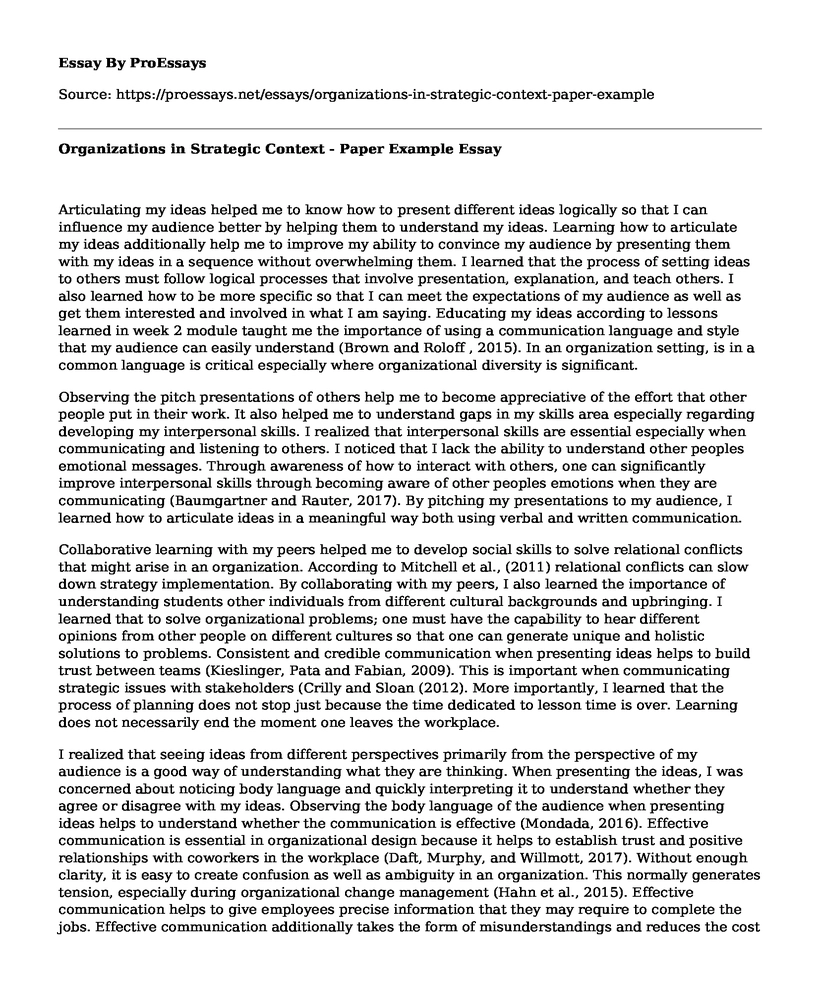Articulating my ideas helped me to know how to present different ideas logically so that I can influence my audience better by helping them to understand my ideas. Learning how to articulate my ideas additionally help me to improve my ability to convince my audience by presenting them with my ideas in a sequence without overwhelming them. I learned that the process of setting ideas to others must follow logical processes that involve presentation, explanation, and teach others. I also learned how to be more specific so that I can meet the expectations of my audience as well as get them interested and involved in what I am saying. Educating my ideas according to lessons learned in week 2 module taught me the importance of using a communication language and style that my audience can easily understand (Brown and Roloff , 2015). In an organization setting, is in a common language is critical especially where organizational diversity is significant.
Observing the pitch presentations of others help me to become appreciative of the effort that other people put in their work. It also helped me to understand gaps in my skills area especially regarding developing my interpersonal skills. I realized that interpersonal skills are essential especially when communicating and listening to others. I noticed that I lack the ability to understand other peoples emotional messages. Through awareness of how to interact with others, one can significantly improve interpersonal skills through becoming aware of other peoples emotions when they are communicating (Baumgartner and Rauter, 2017). By pitching my presentations to my audience, I learned how to articulate ideas in a meaningful way both using verbal and written communication.
Collaborative learning with my peers helped me to develop social skills to solve relational conflicts that might arise in an organization. According to Mitchell et al., (2011) relational conflicts can slow down strategy implementation. By collaborating with my peers, I also learned the importance of understanding students other individuals from different cultural backgrounds and upbringing. I learned that to solve organizational problems; one must have the capability to hear different opinions from other people on different cultures so that one can generate unique and holistic solutions to problems. Consistent and credible communication when presenting ideas helps to build trust between teams (Kieslinger, Pata and Fabian, 2009). This is important when communicating strategic issues with stakeholders (Crilly and Sloan (2012). More importantly, I learned that the process of planning does not stop just because the time dedicated to lesson time is over. Learning does not necessarily end the moment one leaves the workplace.
I realized that seeing ideas from different perspectives primarily from the perspective of my audience is a good way of understanding what they are thinking. When presenting the ideas, I was concerned about noticing body language and quickly interpreting it to understand whether they agree or disagree with my ideas. Observing the body language of the audience when presenting ideas helps to understand whether the communication is effective (Mondada, 2016). Effective communication is essential in organizational design because it helps to establish trust and positive relationships with coworkers in the workplace (Daft, Murphy, and Willmott, 2017). Without enough clarity, it is easy to create confusion as well as ambiguity in an organization. This normally generates tension, especially during organizational change management (Hahn et al., 2015). Effective communication helps to give employees precise information that they may require to complete the jobs. Effective communication additionally takes the form of misunderstandings and reduces the cost of mistakes.
References
Baumgartner, R. and Rauter, R 2017. Strategic perspectives of corporate sustainability management to develop a sustainable organization. Journal of Cleaner Production, 140, pp.81-92.
Brown, L. and Roloff, M 2015. Organizational citizenship behavior, organizational communication, and burnout: The buffering role of perceived organizational support and psychological contracts. Communication Quarterly, 63(4), pp.384-404.
Crilly, D. and Sloan, P 2012. Enterprise logic: Explaining corporate attention to stakeholders from the inside-out. Strategic Management Journal, 33(10), pp.1174-1193.
Hahn, T., Pinkse, J., Preuss, L. and Figge, F 2015. Tensions in corporate sustainability: Towards an integrative framework. Journal of Business Ethics, 127(2), pp.297-316.
Kieslinger, B., Pata, K. and Fabian, C 2009. A participatory design approach for the support of collaborative learning and knowledge building in networked organizations. International Journal of Advanced Corporate Learning (iJAC), 2(3), pp.13-21.
Mitchell, R., Agle, B., Chrisman, J. and Spence, L 2011. Toward a theory of stakeholder salience in family firms. Business Ethics Quarterly, 21(02), pp.235-255.
Mondada, L 2016. Challenges of multimodality: Language and the body in social interaction. Journal of Sociolinguistics, 20(3), pp.336-366.
Daft, R., Murphy, J. and Willmott, H 2017. Organization theory and design: An International Perspective. 3rd ed. Hampshire: Cengage Learnign.
Cite this page
Organizations in Strategic Context - Paper Example. (2021, Sep 01). Retrieved from https://proessays.net/essays/organizations-in-strategic-context-paper-example
If you are the original author of this essay and no longer wish to have it published on the ProEssays website, please click below to request its removal:
- Why I Like the Apple Stock - Essay Sample
- Acquiring and Retaining New Customers and Starting a Business Essay
- Surviving a Plane Crash Essay Example
- Data Warehousing Essay Example
- Paper Example on Move to Higher Price: Lower Sales & Lower Royalties?
- Essay Example on Stevens District Hospital Aims to Increase Market Share, Improve Operating Margin
- AstraZeneca PLC: A Comprehensive Study of Expatriate Management Practices - Essay Sample







